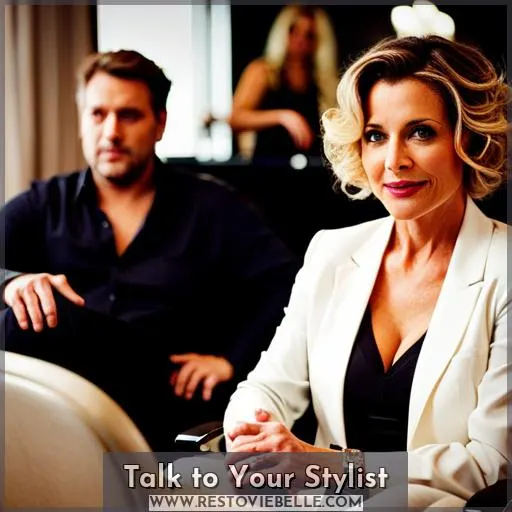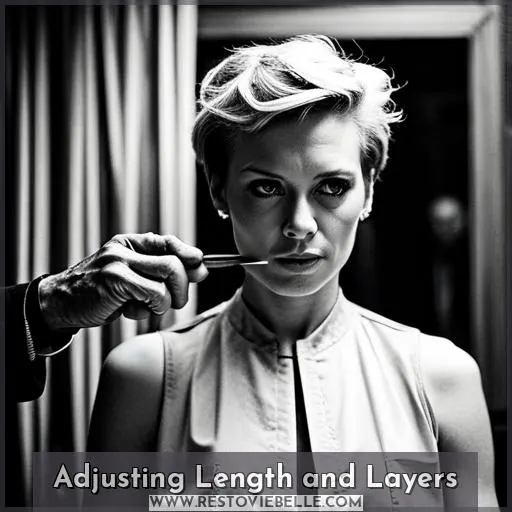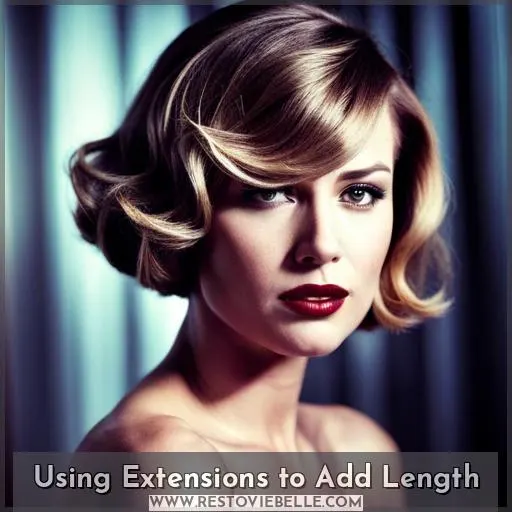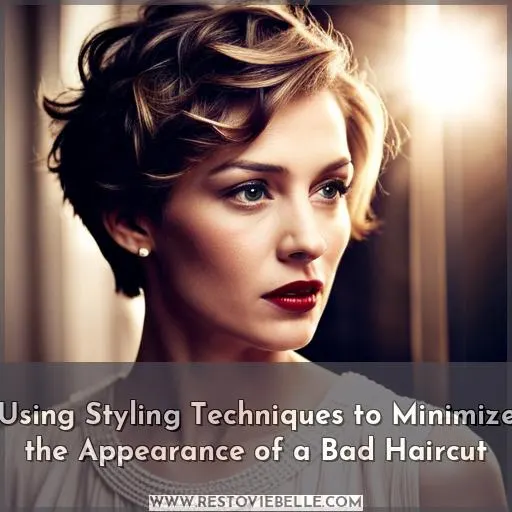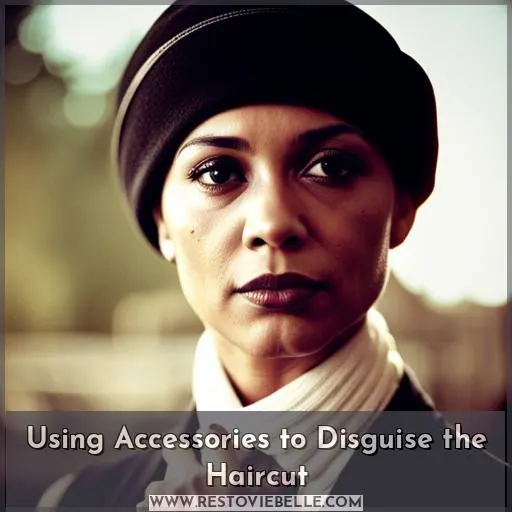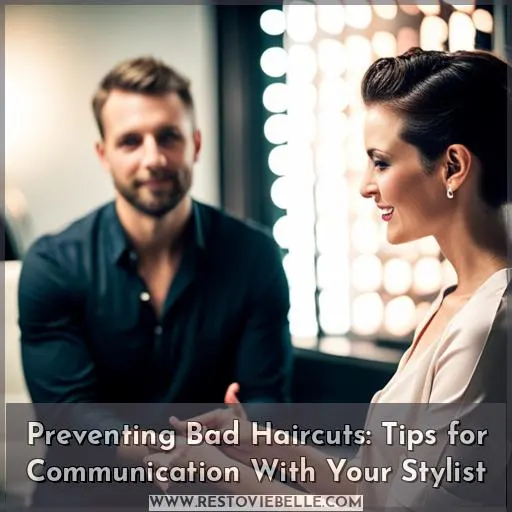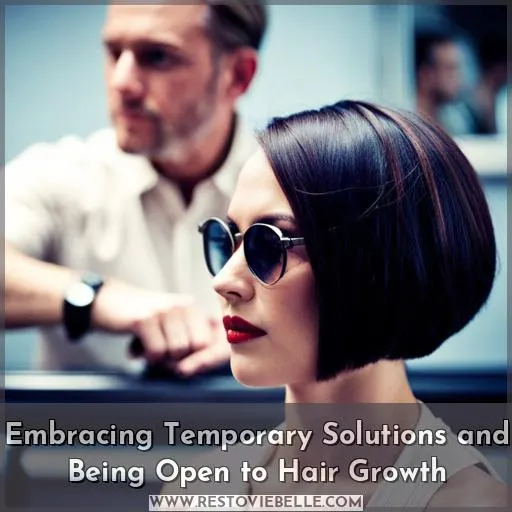This site is supported by our readers. We may earn a commission, at no cost to you, if you purchase through links.
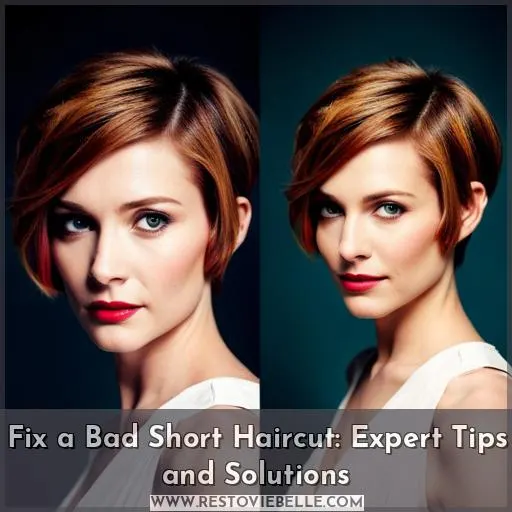 An estimated 30% of people have experienced a haircut gone wrong.
An estimated 30% of people have experienced a haircut gone wrong.
If you’re among the unfortunate ones, don’t panic. There are ways to fix a bad short haircut.
This article will provide expert tips and solutions to help you salvage your new ‘do.
From talking to your stylist and adjusting the length and layers to using extensions and styling techniques, we’ll cover various strategies to minimize the appearance of a bad haircut.
We’ll also discuss how to prevent future mishaps by choosing a skilled stylist and communicating your desired changes effectively.
Table Of Contents
- Key Takeaways
- Talk to Your Stylist
- Adjusting Length and Layers
- Using Extensions to Add Length
- Using Styling Techniques to Minimize the Appearance of a Bad Haircut
- Seeking Professional Help for Corrections
- Patience and Acceptance
- Using Accessories to Disguise the Haircut
- Preventing Bad Haircuts: Tips for Communication With Your Stylist
- Researching and Choosing a Skilled Stylist
- Embracing Temporary Solutions and Being Open to Hair Growth
- Frequently Asked Questions (FAQs)
- How do I ensure that my stylist understands my desired haircut, especially when terms like short and layers can be interpreted differently?
- When getting a corrective haircut, how can I ensure that the stylist takes the time to meticulously analyze and execute the cut, rather than rushing through the process?
- What are some specific techniques that a stylist can use to seamlessly blend and connect layers for a polished and cohesive look?
- How can I effectively communicate with my stylist during the haircut process to ensure that I am satisfied with the outcome and avoid any misunderstandings?
- How do I choose a skilled and reputable stylist who can provide a high-quality haircut, even if it means paying a higher price?
- Conclusion
Key Takeaways
- Consult with your stylist to discuss concerns and schedule a follow-up appointment for adjustments.
- Consider cutting off some length for an even cut and using texturizing products to define layers.
- Use hair extensions that match your natural hair color and texture, and blend them seamlessly for a cohesive look.
- Seek professional help from an experienced stylist for corrective strategies and temporary solutions like hair extensions.
Talk to Your Stylist
How can you mend your relationship with your stylist after a bad haircut?
Open communication is key.
- Schedule a follow-up appointment to discuss your concerns.
- Politely express your dissatisfaction and suggest adjustments.
- Many salons offer a one-week adjustment policy free of charge.
- This shows your stylist that you’re willing to work together to achieve the desired outcome.
During the appointment, bring reference pictures to visually communicate your expectations.
- Be specific about the changes you want.
- Ask questions and listen attentively to your stylist’s suggestions.
This collaborative approach fosters understanding and increases the likelihood of a successful adjustment.
Adjusting Length and Layers
If your haircut has too many layers, consider cutting off some length.
Aligning the new length with the shortest layer creates an even cut.
This provides a blank canvas for future styling and leads to a more manageable and uniform look.
Cutting Off Excess Layers
When fixing a bad short haircut, cutting off excess layers involves:
- Assessing the type of haircut and identifying the issues to determine the best course of action.
If there are too many layers:
- Consider cutting off some length to align the new length with the shortest layer, creating an even cut.
This approach:
- Provides a blank canvas for future styling, facilitating a more manageable and even look.
Aligning Lengths for an Even Cut
By aligning the new length with the shortest layer, you can create an even cut that provides a blank canvas for future styling.
This length harmony ensures a symmetrical solution, eliminating choppy layers and creating a uniform, balanced look.
Precision pairing of each layer’s length creates a seamless transition, achieving the desired hair texture.
Embrace this uniformity quest, as it sets the stage for versatile styling options, empowering you to take control of your hair and regain your confidence.
Using Extensions to Add Length
Second, if your hair is too short to work with, you can use hair extensions to add length and volume. This is a great option if you want to achieve a longer look without waiting for your hair to grow out.
- Choose extensions that match your natural hair color and texture for a seamless blend.
- Use blending techniques to ensure that the extensions blend seamlessly with your natural hair.
- Consider the length and layers of your natural hair when choosing extensions to achieve a cohesive look.
Extensions can help you regain your confidence and feel more like yourself again. With proper care and maintenance, extensions can last for several months, giving you plenty of time to grow out your natural hair.
Using Styling Techniques to Minimize the Appearance of a Bad Haircut
To minimize the appearance of a bad short haircut:
- Use texturizing products to define layers and adapt to changes in hair shape.
- Experiment with different styling techniques, especially for shorter or layered cuts, to find ways to style your hair that you like.
Texturizing Products
To minimize the appearance of a bad short haircut:
- Use texturizing products to define your layers and enhance the shape of your hair.
- Embrace your hair’s natural texture and work with it.
- Use products like sea salt sprays, volumizing mousses, and texturizing creams to add grit, definition, and movement.
- Experiment with different products and techniques to find the perfect combination for your hair.
- Don’t be afraid to ask your stylist for recommendations.
Experimenting With Different Hairstyles
Experimenting with different hairstyles can help you temporarily hide the appearance of a bad haircut. Unleash your inner stylist and embark on a hairdo adventure.
Texture Trials:
Embrace texturizing products to add volume and definition to your locks.
Look Innovations:
Try out trendy transformations like braids, buns, or ponytails to draw attention away from the haircut.
Style Experiments:
Don’t be afraid to throw on a hat or headband to instantly change your look.
Seeking Professional Help for Corrections
If you’re unhappy with your haircut, don’t hesitate to seek professional help from an experienced stylist.
A skilled stylist can assess the situation, provide expert guidance, and suggest corrective strategies to salvage your haircut. They may shorten the hair further, adjust the layers, or recommend temporary solutions like extensions.
Schedule a consultation with your stylist to discuss your concerns. Bring reference pictures of the desired style and explain your dissatisfaction. A professional stylist will listen attentively, understand your vision, and work with you to find a solution that suits your needs.
Seeking professional help ensures a safe and effective solution to your haircut woes. Stylists have the skills, knowledge, and tools to transform a bad haircut into a manageable and stylish ‘do. Embrace their expertise and empower yourself with a renewed sense of confidence in your appearance.
Patience and Acceptance
How can you make peace with the fact that you might have to lose some length to fix your haircut?
Understand that sacrificing length is sometimes necessary for a successful correction.
Trust your stylist’s expertise; they’ll guide you toward a flattering cut that complements your features.
Accepting the reality of the situation empowers you to take charge and work towards a positive outcome.
Embrace the growth process.
Hair grows, and with time, you’ll regain your desired length.
Focus on caring for your hair during this transition.
Utilize temporary solutions like styling products, accessories, or extensions to enhance your look while you wait.
Cultivate emotional resilience.
A bad haircut can be emotionally challenging, but remember, it’s just hair.
Don’t let it diminish your self-worth.
Instead, view it as an opportunity to experiment with different styles and discover new facets of your beauty.
Maintain a growth perspective.
See this experience as a chance to learn and grow.
The next time you get a haircut, you’ll be more informed and better equipped to communicate your preferences to your stylist.
This experience can empower you to take control of your hair journey and make choices that align with your vision.
Using Accessories to Disguise the Haircut
To hide an undesired short haircut, you can utilize various accessories that add flair and distract from the cut:
Colorful Headbands:
These accessories come in various colors, patterns, and textures, allowing you to match your outfit or mood. Headbands draw attention to your face, away from your hair.
Trendy Head Wraps:
Head wraps are versatile and stylish, concealing a bad haircut while adding a touch of elegance. Experiment with different tying techniques to create unique looks.
Hat Fashion:
Hats are a classic way to disguise a haircut you’re not thrilled with. From beanies to baseball caps and fedoras, hats come in a variety of styles to suit your taste.
Scarf Styling:
Scarves aren’t just for winter. Tie one around your head for a chic and effortless look. Choose a scarf with a bold pattern or color to make a statement.
Preventing Bad Haircuts: Tips for Communication With Your Stylist
Talking with your stylist in detail about your desired haircut, using reference pictures and avoiding assumptions, can help prevent bad haircuts. This open dialogue is the cornerstone of a successful stylist-client relationship.
Visual Communication:
Reference pictures are worth a thousand words. They help stylists grasp your vision, minimizing misinterpretations and ensuring you both strive toward the same goal.
Stylist Compatibility:
Choose a stylist who aligns with your style preferences and understands your hair type. Research their work, read reviews, and ask for recommendations to find a stylist who’s a good fit.
Inspiration Pictures:
Bring photos of hairstyles that resonate with you. This visual aid helps stylists comprehend your desired look and incorporate elements that suit your face shape and hair texture.
Avoiding Assumptions:
Never assume that your stylist knows what you want. Clearly articulate your expectations, even if it seems basic. Don’t be afraid to ask questions and seek clarification.
Shared Understanding:
Ensure that you and your stylist are on the same page. Ask them to explain their approach and listen attentively. If something doesn’t make sense, speak up.
Researching and Choosing a Skilled Stylist
Before you sit in the stylist’s chair, research their skills and style.
Look at their portfolio and read reviews to make sure they’re a good fit for you.
Ask friends for recommendations or check social media for stylists whose work you admire.
Finding skilled hairdresser
Moving from ensuring effective communication, you should now dedicate time to researching and choosing a skilled hairdresser who can understand and execute your desired changes.
Seek out salons that prioritize quality and have a rigorous hiring process.
Utilize social media platforms to screen potential stylists, examining their portfolios for examples of their skills and style compatibility.
Consider the cost-quality balance, but remember that investing in a skilled professional may yield more reliable results.
Communicating desired changes
After finding a skilled hairdresser, clearly communicate your desired changes to ensure they understand your vision.
Use visual references like photos to avoid assumptions and foster a shared understanding.
Clearly articulate your personal preferences for the hairstyle you desire.
Effective communication is key in avoiding misunderstandings and achieving the results you want from the stylist.
Using reference pictures
Your stylist’s portfolio acts as a visual guide to assess their skills and style, helping you select a hairdresser who aligns with your desired outcome.
Don’t leave it to chance; take control by showing them pictures of your dream ‘do.
Visual communication is key to bridging the gap between your imagination and their scissors.
These pictorial preferences serve as a compass, guiding your stylist toward a picture-perfect fix.
Embracing Temporary Solutions and Being Open to Hair Growth
Embrace temporary fixes like accessories and extensions while you patiently await your hair’s natural regrowth.
Experiment with scarves, headbands, and hats to add flair and conceal problem areas.
Clip-in extensions can also add length and volume, offering a versatile solution as you transition to your desired style.
Cultivate a growth mindset, understanding that hair is ever-evolving.
Embrace the journey of hair evolution, viewing each stage as an opportunity for self-expression.
Adapt your styling techniques as your hair grows, discovering new ways to enhance its beauty.
Maintain an open dialogue with your stylist, discussing your progress and evolving preferences.
Their expertise can guide you through the growth process, suggesting styling tips and treatments to optimize your hair’s health and appearance.
Frequently Asked Questions (FAQs)
How do I ensure that my stylist understands my desired haircut, especially when terms like short and layers can be interpreted differently?
To ensure your stylist grasps your vision, bring a photo representing your desired style.
Visual references bridge the gap between words and imagination, leading to a haircut that resonates with your aspirations.
When getting a corrective haircut, how can I ensure that the stylist takes the time to meticulously analyze and execute the cut, rather than rushing through the process?
Take control of your haircut destiny.
Do not let haste ruin your look.
Insist on a meticulous analysis and execution, ensuring a transformation that liberates you from bad hair days.
What are some specific techniques that a stylist can use to seamlessly blend and connect layers for a polished and cohesive look?
To seamlessly blend and connect layers for a polished look, your stylist can use precise cutting techniques, ensuring each layer complements the overall style.
Attention to detail and an understanding of layering fundamentals are key for achieving cohesive results.
How can I effectively communicate with my stylist during the haircut process to ensure that I am satisfied with the outcome and avoid any misunderstandings?
In the realm of hair transformations, communication is the compass that guides you to your desired destination.
Speak your vision, bearing pictures as proof, for a shared understanding.
Ask, observe, adjust – a dialogue that sculpts your dream into reality.
How do I choose a skilled and reputable stylist who can provide a high-quality haircut, even if it means paying a higher price?
Uncover stylists’ expertise via social platforms.
Prioritize quality over cost; skilled professionals elevate outcomes.
Embrace your power to choose excellence.
Conclusion
As you navigate the aftermath of a bad short haircut, remember that you’re not alone.
With patience, creativity, and the guidance of skilled professionals, you can transform your unfortunate ‘do into a look you’ll love.
Embrace this opportunity to experiment with different styles and techniques, and you might just discover a new favorite look.

